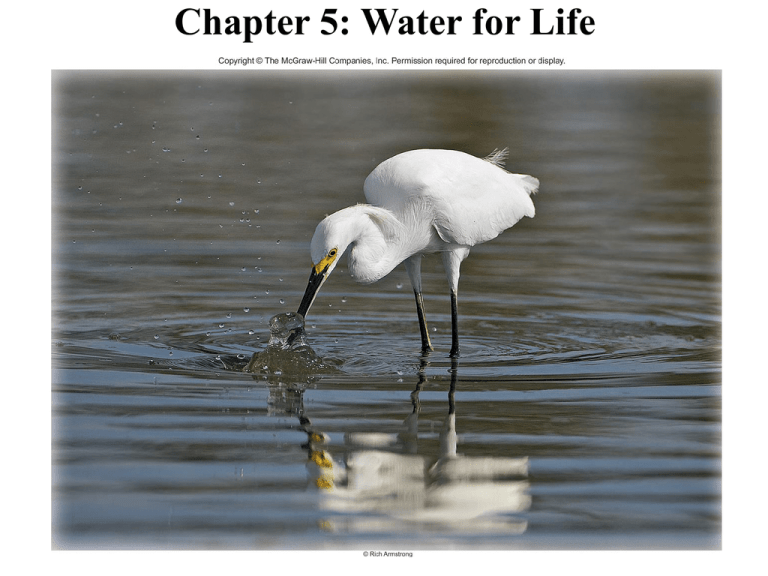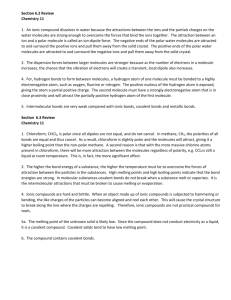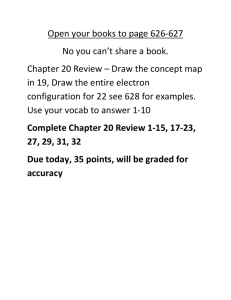CH05 - Chemistry at Winthrop University
advertisement

Chapter 5: Water for Life “Water has never lost its mystery. After at least two and a half millennia of philosophical and scientific inquiry, the most vital of the world’s substances remains surrounded by deep uncertainties. Without too much poetic license, we can reduce these questions to a single bare essential: What exactly is water?” Philip Ball, in Life’s Matrix: A Biography of Water, University of California Press, Berkeley, CA, 2001, p. 115 Do you know where your drinking water comes from? Do you know if your drinking water is safe to drink? How would you know? Different Representations of Water Lewis structures Space-filling 5.1 Water is a very unique molecule. It has a very high boiling point for such a small molecule It is an excellent solvent for many types of compounds The solid form is less dense than the liquid (a very rare property) Has a very high heat capacity The properties of water are due to: It's molecular geometry It's small size And the type of bonds it contains Bond – an attractive force that holds two atoms together. Atoms bond to obtain a more stable electronic configuration. They do this by gaining, losing, or sharing electrons with other atoms Covalent (molecular) bonds Between non-metals and non-metals Atoms tied together by sharing electrons Forms molecules – fixed numbers of atoms in a particular geometry Ionic bonds Between metals and non-metals Attraction between oppositely charged atoms/molecules (ions) Formula shows the ratio of ions Metallic bonds Between two or more metals Outer electrons are not linked to a particular atom, as in covalent and ionic bonding These electrons are shared between all atoms in a 'sea of electrons' This is why metals conduct electricity and heat so well For Covalent and Ionic Bonding: The electronegativity determines what type of bond will form between two atoms Electronegativity (EN)– attraction for shared electrons Fluorine is the most EN element Francium the least EN element Larger EN – stronger attraction for bonding electrons Covalent Bonds There are two types of covalent bonds: Non-polar (covalent) Bonding electrons are equally shared When a non-metal bonds to itself, or to another non-metal with a similar EN Polar (covalent) Bonding electrons are shared, but not equally One atom has a larger EN than the other Covalent Bonds Polar (covalent) Usually between non-metals two or more spaces apart on the periodic table The atom with greater EN (closer to F) pulls harder on the shared electrons This pull creates a polarity, or dipole, across the bond: The atom with the higher EN has a slight negative charge The other has a slight positive charge A difference in the electronegativities of the atoms in a bond creates a polar bond. O H H Partial charges result from bond polarization. A polar covalent bond is a covalent bond in which the electrons are not equally shared, but rather displaced toward the more electronegative atom. 5.1 Polarity of hydrogen covalent bonds is difficult to tell from the PT: H-C – non-polar (some books list as very slightly polar) H-O – very polar H-N – very polar H-F – very polar Ionic Bonds If the electronegativity difference is large enough between two atoms, they will not share the 'bonding' electrons: The atom with the greater EN takes the 'bonding' electrons from the other atom This atom then has a negative charge The atom that lost the electron(s) has a positive charge Ions Cations – lost one or more electrons positively charged Anions – gained one or more electrons negatively charged When forming ions, atoms usually want to get to the same number of electrons as the nearest Noble Gas Group Ion usually formed 1 (1A) +1 H can form -1 ion 2 (2A) +2 13 (3A) +3 14 (4A) +/-4 15 (5A) -3 16 (6A) -2 17 (7A) -1 18 (8A) 0 Naming Ions: ●Cation (metal) – name is the same as the element, + 'ion' ●Fixed charge cations – metals that only form one cation (such as Group 1 and 2 metals): Li+1 → lithium ion, Ca+2 → calcium ion ●Variable charged cations – metals that may form different cations (most transition metals)Use Roman numerals to show the charge: Fe+2 → iron (II) ion Fe+3 → iron (III) ion ●Anion (non-metal) – use the root of the element name, change the ending to 'ide', + 'ion': S → S-2 sulfur → sulfide ion N → N-3 nitrogen → nitride ion O → O-2 oxygen → oxide ion Naming Binary Ionic Compounds: ●List the cation first, then the anion ●Do not include 'ion' in the name ●Names must be distinctive, in order to distinguish between similar compounds, such as with variable-charged metals NaCl – sodium chloride CaF2 – calcium fluoride FeI2 – iron (II) iodide FeI3 – iron (III) iodide Writing formulas for binary ionic compounds: ●The formula shows a ratio of one ion to the other. ●The ionic charges must cancel out so that the overall charge is neutral ●Always list the metal first, then the non-metal ●Select subscripts to balance charges ●Reduce subscripts if needed to obtain the lowest whole number ratio between ions To determine the charge on a variable charge cation, treat the formula as an algebraic expression: To determine the iron charge in Fe2O3 ●let Fe = x and O = y (x and y are ionic charges) ●the charges of the ions must add up to the overall charge, which is 0 in this case, so 2x + 3y = 0 ●we know that y = -2 (oxide ion) 2x + 3 (-2) = 0 x = +3 ●so Fe2O3 is named iron (III) oxide H H H2 has a nonpolar covalent bond. A water molecule is polar – due to polar covalent bonds and the shape of the molecule. NaCl NaCl has an ionic bond – look at the EN difference. Na = 1.0 Cl = 2.9 EN = 1.9 5.1 Polyatomic Ions These are covalently bonded atoms with an overall charge (an ionic molecule): NO3-1 – nitrate ion ClO3-1 – chlorate ion C2H3O2-1 – acetate ion OH-1 – hydroxide ion SO4-2 – sulfate ion CO3-2 – carbonate ion PO4-3 – phosphate ion H3O+1 – hydronium ion NH4+1 – ammonium ion (NH3 – ammonia) Intermolecular Forces Polar bonds can result in polar molecules. For molecules like CO2, the polar bonds cancel each other out. For other molecules, like water, the polar bonds cause slight positive and negative ends on each molecule. Intermolecular Forces The dipoles on one molecule are attracted to the dipoles on other molecules. This is an example of intermolecular attractive force. Water molecules are extremely polar, and so have strong intermolecular attraction. This is why water has such a high boiling point. N2 is a heavier molecule, but with little intermolecular attraction, it's boiling point is 300°C lower than that of water Polarized bonds allow hydrogen bonding to occur. A hydrogen bond is an electrostatic attraction between an atom bearing a partial positive charge in one molecule and an atom bearing a partial negative charge in a neighboring molecule. The H atom must be bonded to an O, N, or F atom. Hydrogen bonds typically are only about one-fifteenth as strong as the covalent bonds that connect atoms together within molecules. H–bonds are intermolecular bonds. Covalent bonds are intramolecular bonds. 5.2 Intermolecular Forces The dipole/dipole interaction is like a weak ionic bond. For this reason, water is also able to dissolve many ionic compounds. Several water molecules can surround ions and bring them into solution. Substances that will dissociate in solution are called electrolytes. Ions are simply charged particles – atoms or groups of atoms. They may be positively charged – cations. Or negatively charged – anions. Dissolution of NaCl in Water NaCl(s) H2O Na+(aq) + Cl–(aq) The polar water molecules stabilize the ions as they break apart (dissociate). 5.8 Intermolecular Forces Polar bonds can result in polar molecules. For molecules like CO2, the polar bonds cancel each other out. For other molecules, like water, the polar bonds cause slight positive and negative ends on each molecule. Water on Earth Only 3% of all water is fresh (potable) Of this: 68% is in glaciers 30% is underground 1% in the atmosphere only 0.3% in lakes, rivers, streams Water Footprint The average person needs 1E6 (1 million) liters per year. This is equivalent to 250000 gallons, half of an Olympic sized pool. Some of this water is used directly, and some indirectly. Directly used water includes: Drinking water Bathing water Water used for washing dishes Water used for washing clothes Toilet water Indirectly used water includes: Water for crops Water for livestock Water needed for services, Electrical power Waste treatment Water needed for industry Production of consumer goods Construction Water Footprint Water is necessary to produce food: 5.3 Water Footprint Water is necessary for products: 5.3 Fresh Water Surface water – Lakes, rivers, streams Easily accessible Not abundant enough to meet our needs May need to be filtered/treated to drink Ground water – Underground in aquifers (trapped in geological formations) Harder to access More abundant Often drunk without treatment The average American uses almost 100 gallons of water a day. Nearly ¾ of the water entering our homes goes down the drain. Much of our clean water comes from underground aquifers. The Ogallala Aquifer is shown in dark blue. While normally free of pollutants, groundwater can be contaminated by a number of sources: Abandoned mines Runoff from fertilized fields Poorly constructed landfills and septic systems Household chemicals poured down the drain or on the ground 5.4 Salt Water Very abundant (97% of all water on Earth) Easily accessible, at least near coasts Not potable due to high salt content Difficult to purify for human consumption Access to safe drinking water varies widely across the world. 5.4 Solutions Solutions are one pure substance (compound or element) dissolved in another Solute – what is being dissolved (minor component) Solvent – what the solute is dissolved in (major component) Solution – solute/solvent mixture Solutions Usually, solvents dissolve solutes of similar chemical structure (“like dissolves like”) Non-polar solvents dissolve non-polar solutes: oil and gasoline Polar solvents dissolve polar solutes: water and sugar But oil and water will not mix Covalent molecules in solution A sucrose molecule – when dissolved in water, sugar molecules interact with and become surrounded by water molecules, but the sucrose molecules do not dissociate like ionic compounds do; covalent molecules remain intact when dissolved in solution. They will not conduct electricity; they are nonelectrolytes. 5.9 Like dissolves like 5.9 Solutions Water is also able to dissolve many ionic compounds due to it's strong polarity Even 'insoluble' solutes may be very slightly soluble When ions (charged particles) are in aqueous solutions, the solutions are able to conduct electricity. (a) Pure distilled water (nonconducting) (b) Sugar dissolved in water (nonconducting): a nonelectrolyte (c) NaCl dissolved in water (conducting): an electrolyte 5.6 Pure water – very poor electrical conductor Water – very good solvent Therefore, pure water is hard to obtain Dissolved ions make water a good conductor Any soluble ionic compound splits apart into ions in solution Simple generalizations about ionic compounds allow us to predict their water solubility. *Insoluble means that the compounds have extremely low solubility in water (less than 0.01 M). All ionic compounds have at least a very small solubility in water. 5.8 Concentration A ratio of solute to solvent Independent of the amount of solution For very small concentrations, often measured in ppm or ppb For aqueous solutions, we often use Molarity Concentration Terms Parts per hundred (percent) 20 g of NaCl in 100 g of water is a 20% NaCl solution Parts per million (ppm) Parts per billion (ppb) 2 g Hg 2 10-6 g Hg 2 g Hg 2 ppb Hg 9 3 110 g H 2O 110 g H2O 1 L H2O 5.5 Molarity (M) moles of solute Molarity= liters of solution n M= V Molarity makes conversion between moles and volume easy to calculate. How to prepare a 1.00 M NaCl solution: solute M = Lmol of solution Note – you do NOT add 58.5 g NaCl to 1.00 L of water. The 58.5 g will take up some volume, resulting in slightly more than 1.00 L of solution – and the molarity would be lower. 5.5 Maximum Contaminant Level (MCL) Maximum allowed concentration for minimal risk to humans Depends on the contaminant: heavy metals, solvents, other chemicals The MCL for a contaminant may be set by the federal government, state, county, or city. Maximum Contaminant Level Goal (MCLG) and Maximum Contaminant Level (MCL) 5.10 Nitrate concentrations from California domestic groundwater wells and agricultural irrigation 5.10 Typical steps used to treat fresh water from rivers/streams/aquifers for drinking: Filter particulates Use flocculating agents to remove smaller particles (traps particles together for filtration) Treat to remove/kill bacteria Chlorination or Ozone or UV irradiation Schematic drawing of a typical municipal water treatment facility. 5.11 Chlorination Most common method to treat water Uses hypochlorous acid (HClO), the same compound used in swimming pools Kills microorganisms Keeps treating from facility, through pipes, up to the point of use (home/factory) Ozone Works well to kill microorganisms Expensive Short lifetime, quickly decomposes Does not protect water after leaving the treatment facility UV Irradiation UV light used to kill microorganisms Easy to implement Cheaper than O3 Only treats water at exposure, so offers no protection after leaving treatment facility Purification of water – removing all particulates, organisms, dissolved ions/compounds Distillation – boil water and condense steam to obtain pure water (very minor impurities) Purifiers/filters – series of filters/membranes Each filter removes certain types of contaminants Expensive, not practical for large volumes Making freshwater from saltwater Desalinization – a process that removes ions from saltwater 5.12 Making freshwater from saltwater – continued Distillation – a separation process in which a liquid solution is heated and the vapors are condensed and collected Either perform distillation in laboratory (left) or use solar power (right). 5.12 Reverse osmosis – produces very pure water Water is forced through a special membrane that only allows very small molecules to penetrate Requires a lot of energy Not currently practical for large volumes Making freshwater from saltwater – continued Osmosis – the passage of water through a semipermeable membrane from a solution that is less concentrated to a solution that is more concentrated Reverse Osmosis – uses pressure to force the movement of water through a semipermeable membrane from a solution that is more concentrated to a solution that is less concentrated 5.12 LifeStraw – created for developing countries to remove bacteria, viruses, and parasites from water to use for drinking 5.12 Water, water, every where, And all the boards did shrink; Water, water, every where, Nor any drop to drink. And every tongue, through utter drought, Was withered at the root; We could not speak, no more than if We had been choked with soot. The Rime of the Ancient Mariner, excerpt Samuel Taylor Coleridge





